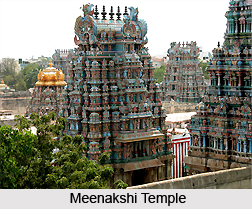 Times have changed but the temple city of Madurai has retained the essentials of culture of yore. The history of Madurai dates back to the 6th century BC. It was the capital of the Pandyan Empire till the 14th century. It was also the seat of Tamil learning. The last of the three Tamil Sangams (Academies) flourished here nearly 2,000 years ago. Madurai can easily be termed as the temple city of Tamil Nadu. Madurai is one of the 51 Shakti Peethas and the temple is the seat of `Bhudha.`
Times have changed but the temple city of Madurai has retained the essentials of culture of yore. The history of Madurai dates back to the 6th century BC. It was the capital of the Pandyan Empire till the 14th century. It was also the seat of Tamil learning. The last of the three Tamil Sangams (Academies) flourished here nearly 2,000 years ago. Madurai can easily be termed as the temple city of Tamil Nadu. Madurai is one of the 51 Shakti Peethas and the temple is the seat of `Bhudha.`
To reach Madurai one can avail the flights, railways or the roadways. It is accessible from Chennai (460 km), Kanniyakumari (245 km), Bangalore (435 km), Hyderabad (995 km) and other cities.
Tourists can start with the Madurai Temple. Pandya rulers lavished their skill and resources on the architecture of this shrine. It is a twin temple dedicated to Sundareswarar and His consort Meenakshi. There are 11 gopurams, the most attractive of them being the one at the southern entrance rising to a height of 160 feet with a parabolic curve. The Golden Lotus Tank inside the temple is surrounded by spacious corridors. Its walls are further covered with paintings depicting the Lord`s miracles. Adjacent to the tank are the Unjal Mandapam and the Kilikoottu Mandapam. The long rows of pillars here contain delicately-carved figures.
There is a special Peetam in a six-pillared mandapam where the coronation of all Nayak kings took place. The coronation of Meenakshi is also performed on this Peetam every year during the Chitrai festival. Goddess Meenakshi is believed to have been born as the daughter of a Pandya King and Siva as Sundareswarar, married her.
There are two temples within this compound
Meenakshi shrine: In the sanctum, the Goddess stands with a parrot and bouquet, radiating love and compassion. Meenakshi is conceived as Mother in Her loving mood.
Sundareswarar shrine: A large image of Ganesha greets the pilgrims as they proceed to the Sundareswarar temple. In front of the shrine is the famous Kampathadi Mandapam. This contains many finely sculptured pillars, including one depicting the wedding of Meenakshi. The beautiful figures of Lord Shiva, incarnations of Vishnu and other statues are striking illustrations of excellence of Dravidian art.
The Hall of Thousand Pillars is magnificently sculptured. In the Velliambalam, Lord Nataraja is seen in the dancing pose with His right foot raised. Usually Nataraja is depicted as dancing with His left foot raised. It is believed that here He did so in order to please His devotee, King Raja Sekhara Pandya. The dance is known as Gnanasundara Thandavam.
The main wonder of this temple is that the 985 pillars appear in a straight line from whichever angle one looks at them. An exhibition of many antiques, idols and interesting pieces of art is arranged here.
The Vasanta Mandapam, where the deities are placed during festivals, contains rare stone images. The Nayak rulers have been immortalized in brilliant statues.
Festivals in the Temples: Madurai is a city of festivals. The most important festival is the Meenakshi-Sundareswarar wedding on Chitra Poornima day. it is usually held in either April or May. The 64 Leelas of the Lord are commemorated round the year during different festivals. The illuminated Float Festival on Thai Poosam day (Jan-Feb) attracts a large number of pilgrims.











